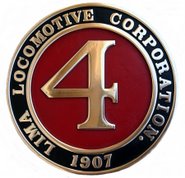That doesn't mean work has stopped at the engine house. During this time two dedicated members of the Shay team have continued work in the shops at the El Dorado County Historical Museum.
Lead machinist Sam Thompson continues to make the weekly drive to Placerville from his Bay Area home. He has focused on rehabilitating the Shay's three engines. The second member, Mark Bruto, has divided his time between the engine house and railroad park.
The team has focused on the bearings for the eccentrics on the crankshaft. Using Babbitt donated to the railroad by the CemexUSA plan in Pleasanton, California, Sam and Mark devised a simple process to form the bearings.
The photographs show the process Sam and Mark used yesterday to form the third of six bearings:
 Sam tightens the bolts after placing shims between the halves of the eccentric strap. The shims act as dams. They form two distinct halves as the bearing is molded. The round fixture at the bottom of the picture is used to form the inside diameter of the bearing.
Sam tightens the bolts after placing shims between the halves of the eccentric strap. The shims act as dams. They form two distinct halves as the bearing is molded. The round fixture at the bottom of the picture is used to form the inside diameter of the bearing. Sam makes final adjustments as he centers the eccentric strap around the ring mold. Sam and Mark next clamped the strap to the ring mold to immobilize it.
Sam makes final adjustments as he centers the eccentric strap around the ring mold. Sam and Mark next clamped the strap to the ring mold to immobilize it. A little after 10 a.m., Mark began melting the Babbitt. Babbitt is the soft white metal that's used to make the bearing. According to Sam, the material consists of approximately 92 percent tin. Antimony and copper make up the rest of the alloy.
A little after 10 a.m., Mark began melting the Babbitt. Babbitt is the soft white metal that's used to make the bearing. According to Sam, the material consists of approximately 92 percent tin. Antimony and copper make up the rest of the alloy. Sam drops a handful of Babbitt shavings into the molten Babbitt. The shavings melted as soon as they fell into the pool. The Babbitt is heated to 460 to 470 degrees. Mark said the Babbitt it ready to pour when it takes on a straw color.
Sam drops a handful of Babbitt shavings into the molten Babbitt. The shavings melted as soon as they fell into the pool. The Babbitt is heated to 460 to 470 degrees. Mark said the Babbitt it ready to pour when it takes on a straw color. Mark pours the molten Babbitt into the mold around 11:15 a.m. Although difficult to see, Mark and Sam used duct seal, a clay-like material, to keep the molten Babbitt inside the mold. A second line of duct seal formed a gasket under the eccentric strap.
Mark pours the molten Babbitt into the mold around 11:15 a.m. Although difficult to see, Mark and Sam used duct seal, a clay-like material, to keep the molten Babbitt inside the mold. A second line of duct seal formed a gasket under the eccentric strap. Sam said that he would cool the bearing for an hour or more before splitting it into halves. He heated the mold in an oven to 250 degrees before pouring the Babbitt. This prevented the Babbitt from prematurely solidifying as it spread in the mold.
Sam said that he would cool the bearing for an hour or more before splitting it into halves. He heated the mold in an oven to 250 degrees before pouring the Babbitt. This prevented the Babbitt from prematurely solidifying as it spread in the mold. Sam is currently machining the second bearing on the mill in the machine shop. Mark and Sam try to mold a bearing every other Saturday. Sam uses the middle Saturday between pours to machine the bearing to specifications.
Sam is currently machining the second bearing on the mill in the machine shop. Mark and Sam try to mold a bearing every other Saturday. Sam uses the middle Saturday between pours to machine the bearing to specifications.






























